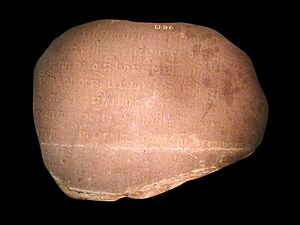Sanghyang Tapak inscription facts for kids
Quick facts for kids Sanghyang Tapak inscription |
|
|---|---|

Inscription No. D96, one of the four Sanghyang Tapak stone inscriptions, also known as Jayabupati inscription or Cicatih inscription
|
|
| Material | Stone |
| Writing | Kawi script |
| Created | 952 saka (1030 CE) |
| Discovered | Cicatih River bank in Cibadak, Sukabumi, West Java, Indonesia |
| Present location | National Museum of Indonesia, Jakarta |
| Registration | D.72, D.96, D.97, D.98 |
| Language | Old Sundanese |
The Sanghyang Tapak inscription is an ancient stone writing from the year 1030 CE. It is also known as the Jayabupati inscription or Cicatih inscription. This important historical text is carved onto four large stones. It tells us about a special protected area called Sanghyang Tapak. This area was created by a king named Jayabhupati.
These four stone inscriptions were found near the Cicatih River in Cibadak, Sukabumi, West Java. Three stones were found in Kampung Bantar Muncang. One stone was found in Kampung Pangcalikan. The writings are in an old Javanese script called Kawi script. Today, you can see all four inscriptions at the National Museum of Indonesia in Jakarta. They are labeled with codes D 73, D 96, D 97, and D 98.
Contents
What the Inscription Says
The Sanghyang Tapak inscription shares an important message from King Jayabhupati. It starts with a wish for peace and well-being. The inscription explains that on a specific date in 1030 CE, King Jayabhupati made his mark on the eastern part of Sanghyang Tapak.
Rules for the Protected Area
The inscription clearly states that no one is allowed to break the rules set for this area. For example, it was forbidden to catch fish in the river within the sacred Sanghyang Tapak area. The protected zone stretched from the river's source to a border marked by two large trees.
The King's Oath
To make sure these rules were followed, King Jayabhupati made a strong oath. This oath is written on the fourth stone (D 98). It calls upon all powerful beings and gods from the sky and earth. These beings were asked to protect the king's command. The oath warned that anyone who broke these laws would be punished by these supernatural powers.
When Was the Inscription Made?
Experts believe the Jayabupati inscription was created on October 11, 1030. Historical records suggest that King Jayabupati ruled for 12 years, from 1030 to 1042 AD. Interestingly, the writing style of these inscriptions looks like the style used in East Java. Even the king's noble name is similar to names of kings from the Dharmawangsa court. In another old story called Carita Parahyangan, King Jayabupati is known as Prabu Detya Maharaja. He was the 20th king of the Sunda Kingdom.

